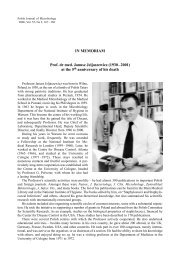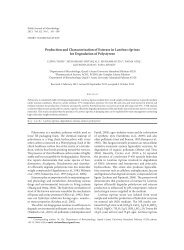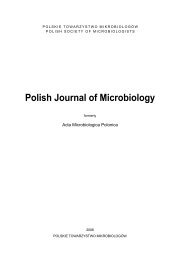No 3 - Polish Journal of Microbiology
No 3 - Polish Journal of Microbiology
No 3 - Polish Journal of Microbiology
Create successful ePaper yourself
Turn your PDF publications into a flip-book with our unique Google optimized e-Paper software.
<strong>Polish</strong> <strong>Journal</strong> <strong>of</strong> <strong>Microbiology</strong><br />
2011, Vol. 60, <strong>No</strong> 3, 203–207<br />
ORIGINAL PAPER<br />
Expression <strong>of</strong> Helicobacter pylori ggt Gene in Baculovirus Expression System<br />
and Activity Analysis <strong>of</strong> its Products<br />
Introduction<br />
Helicobacter pylori is a common human pathogen<br />
that colonizes the gastric mucosa. Infection puts the<br />
individual at greater risk for developing gastritis, peptic<br />
ulcer disease, and gastric cancer (Marshall and Warren,<br />
1984; Bjorkholm et al., 2003; Sharma and Vakil, 2003).<br />
H. pylori produces a number <strong>of</strong> virulence factors that<br />
enable its pathogenesis. One <strong>of</strong> these is an enzyme,<br />
γ-glutamyltranspeptidase (GGT, EC 2.3.2.2), in the<br />
periplasm, which is involved in induction <strong>of</strong> host cell<br />
apoptosis (Shibayama et al., 2003) and plays an important<br />
role in colonization by H. pylori (Chevalier et al.,<br />
1999; McGovern et al., 2001).<br />
GGTs are fairly ubiquitous with homologues observed<br />
in all kingdoms, and are generally considered to<br />
be involved in the metabolism <strong>of</strong> glutathione and in<br />
the salvaging <strong>of</strong> cysteine (Hanigan and Ricketts, 1993;<br />
Ikeda and Taniguchi, 2005). Although distant GGTs<br />
<strong>of</strong>ten share considerable sequence identity, significant<br />
catalytic differences exist between bacterial and nonbacterial<br />
homologues (Ikeda et al., 1995; Ikeda et al.,<br />
1996). Mammalian GGTs are embedded in the plasma<br />
membrane by a single N-terminal transmembrane<br />
anchor and are heterologously glycosylated, bacterial<br />
homologs are soluble and localized to the periplasmic<br />
space. H. pylori GGT (HpGT) is a member <strong>of</strong> the<br />
N-terminal nucleophile hydrolase superfamily, and is<br />
translated as an inactive proenzyme that undergoes<br />
MEI KONG, MING xU, YA-LONG HE and YOU-LI ZHANG*<br />
department <strong>of</strong> Gastroenterology, the Affiliated Hospital <strong>of</strong> Jiangsu University<br />
Received 21 december 2010, revised 26 June 2011, accepted 6 July 2011<br />
Abstract<br />
The γ-glutamyltranspeptidase (GGT) <strong>of</strong> Helicobacter pylori (HpGT) is a newly found virulence factor. In an approach to gain insight into the<br />
gene function, the four domains <strong>of</strong> the HpGT were cloned and expressed in baculovirus expression system. The results <strong>of</strong> a functional assay<br />
showed that the HpGT products acted as GGT, even when the N-terminal 380 amino acids were deleted. However, only the full length open<br />
reading frame (ORF) <strong>of</strong> the HpGT gene was apparently effective on cell growth. This result indicated that the products <strong>of</strong> the full length ORF<br />
might have an important role in gastric carcinogenesis. In this paper, we are the first to report that changes <strong>of</strong> mitochondrial membrane<br />
potential can be detected using 5, 5’, 6, 6’-tetrachloro-1, 1’, 3, 3’-tetraethylbenzimidazole carbocyanine iodide (JC-1) staining in insect cells.<br />
K e y w o r d s: glutamyltranspeptidase; Helicobacter pylori; membrane potential; virulence factor<br />
autoprocessing to become an active enzyme (Brannigan<br />
et al., 1995). despite its demonstrated involvement in<br />
H. pylori colonization, persistence, and disease progression<br />
(Boanca et al., 2007), the biochemical characterization<br />
<strong>of</strong> HpGT is still limited (Coloma and Pitot 1986).<br />
Although the general features <strong>of</strong> the function <strong>of</strong> HpGT<br />
can be inferred based on its classification as an N-terminal<br />
nucleophile hydrolase, many mechanistic details<br />
<strong>of</strong> the autoactivation and catalytic function <strong>of</strong> HpGT<br />
have not been addressed. In this paper, the domains <strong>of</strong><br />
the HpGT gene were expressed in baculovirus expression<br />
system and subsequently analyzed.<br />
Experimental<br />
Materials and Methods<br />
The E. coli dH10Bac/BmNPV cell line was provided<br />
by Pr<strong>of</strong>essor E.Y. Park (department <strong>of</strong> Applied Biological<br />
Chemistry, Faculty <strong>of</strong> Agriculture, Shizuoka University,<br />
Shizuoka, Japan).<br />
FuGENE TM 6 transfection reagent was from Roche<br />
Company. Grace’s insect cell culture medium (GIBCO)<br />
was purchased from Invitrogen. The B. mori cell line<br />
BmN (originated from ovary) was preserved in our<br />
laboratory and cultured at 27°C in Grace’s insect cell<br />
culture medium.<br />
H. pylori culture. H. pylori strain was isolated from<br />
clinic tissues. The strains were grown on horse blood<br />
* Corresponding author: Y-L. Zhang, department <strong>of</strong> Gastroenterology, the Affiliated Hospital <strong>of</strong> Jiangsu University; Jiefang Road 438,<br />
Zhenjiang 212001, Jiangsu Province, China; e-mail: youlizhang1972@126.com






